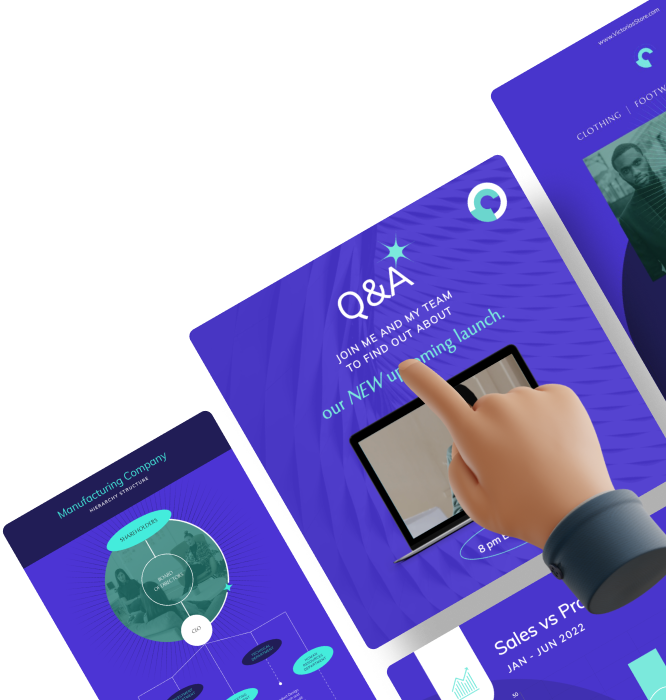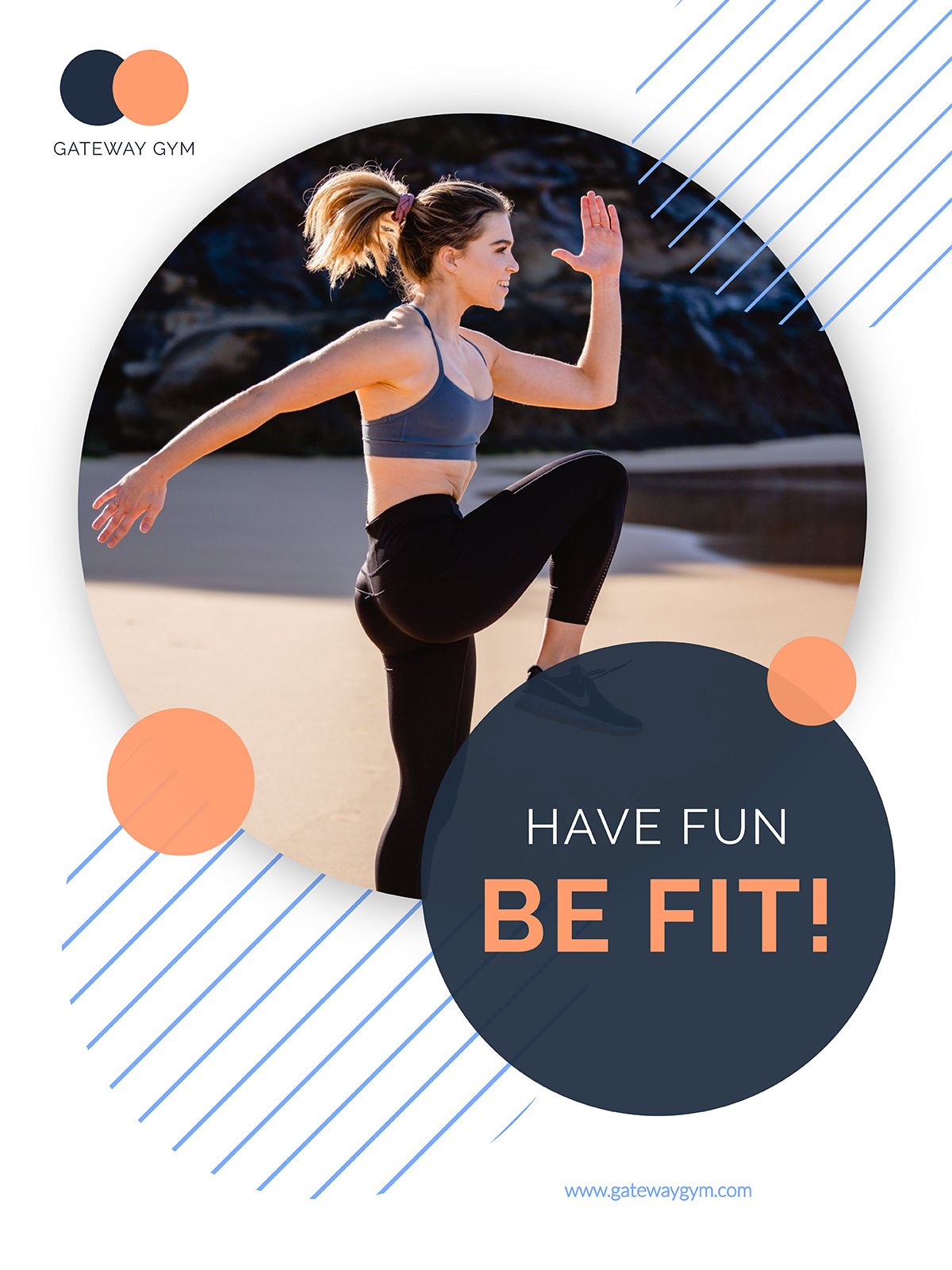
16 Marketing Materials for Small Businesses (Print & Digital)


Promoting your brand’s products and services is easy when you have eye-catching and effective marketing materials. From emails to Instagram stories, marketing materials span various platforms, both digital and physical.
If you’re not sure what type of marketing material you need, this guide will give you a clear idea of what’s possible. Then, select a customizable template on the list and start designing with our professional document creator.
Here’s a short selection of 8 easy-to-edit marketing materials you can edit, share and download with Visme. View more templates below:
Use the table of contents below, navigate to the marketing material that interests you, or simply scroll down.
Marketing materials are any type of content that help tell the story of your brand, or sell to or inform your audience. There are two main types of marketing materials: print or digital.
Print marketing materials are any type of asset that needs printing and is distributed physically.
A typical example of a printed marketing asset is the brochure. Furthermore, there are also flyers, posters and event programs. Printed materials were a lot more common before the spread of handheld devices and digital marketing.
Nowadays, print marketing is mainly used by small businesses, growing their audience with people from their community. Printed materials for marketing are also relevant in large conferences or trade shows, where visitors collect information from the booths they visit.
Digital marketing materials range from social media graphics to slide presentations. Marketing collateral for the online space is highly varied and can be shared in different ways:
There are endless opportunities for creating useful marketing collateral.
Sign up. It's free.Create any type of marketing material with Visme!
Successful marketing and promotion strategies are impossible to achieve without a set of visual marketing materials. They’re the representation of your brand, story and offer. Without them, you have no way of communicating with your target audience.
Let’s take a look at some reasons why your brand needs marketing materials as soon as day one.
The most important reason why you need marketing materials is their communication power. They’re the visual language to spread your brand story and what you have to offer.
With a good mix of classic elements like your logo, some well-designed graphics and cutting-edge video material, your brand message will spread far and wide.
An essential factor in effective brand communication is reaching the right audience. The best way to do that is with marketing materials specially crafted to tell your brand’s story.
As your audience gains awareness with social media graphics and online ads, you can continue communication with emails and webinars.
Like I mentioned above, no marketing strategy is complete without marketing materials. This sentiment applies to both content marketing and digital marketing. Better still, it also applies to event marketing, both in-person and online.
You can’t promote an offer or service if you don’t have visuals and a message. It’s as simple as that.
The most important reason of all is that your marketing materials can make an impact. More so if crafted well, following detailed brand guidelines.
What does impact do that’s so important? It creates brand loyalty and—with time—also brand equity. It makes your brand timeless and important. It has a longer shelf life than press releases, communication plans and new releases.
Moving on. Are you ready to get started? Let’s go through the most used marketing materials and some tips on getting them right.

The first marketing material on our list is the brochure. The faithful trifold brochure has been an essential part of promotional marketing since we knew the meaning of marketing.

A brochure is a handout overview of your business and its offerings. It typically presents itself as a double sided paper that’s been folded along two lines to create three panels with two sides. Once the panels are folded over each other, you’ve got a physical booklet for potential customers to open and look through. You can even make it a digital booklet that can be shared online.
The purpose of a brochure is to relay important information about your company as a whole, or for a specific service/product. They’re either distributed in person or left in a brochure stand for interested parties to pick up.
Brochures aren’t as common as they were before the internet, but they’re making a comeback because they still work.
If you’re considering using this marketing material, here are a few ideas:
Keep in mind:
For a brochure to be successful, it needs to include contact information. Since it’s printed, it's a good idea to add a QR code for people to scan with their phones and provide an interactive marketing experience, or share additional information.
Flyers are similar to brochures, but are presented in a different manner. Remember that unless a flyer has an eye-catching design, it tends to end up in the garbage.

A flyer isn’t folded; it’s usually a single printed page, with information on either one or both sides. They’re handed out at busy public areas, left on coffee shop counters, inserted into shopping bags, put in mailboxes and sent out as emails.
The purpose of a flyer is to share information about a specific product, event, shop, etc. It’s much simpler than a brochure in that it can’t contain that much information.
Flyers are found pretty much everywhere. How many times have you been handed a flyer while walking down the street? How many times have you picked up a flyer in a coffee shop? How many flyers show up in your mailbox every week?
Keep this in mind if you plan to test flyers for your business so you know where to start distributing them.
Keep in mind:
If you choose to create flyers as marketing materials, make sure they’re eye-catching and exciting. Otherwise, they’ll just end up in the bin. Always add a QR code to make it easy for people to find your information online.
In a digital sense, flyers and posters are essentially interchangeable. But in the realm of printed marketing materials, they’re used in different ways. Let’s take a look.

A poster is a printed marketing material that is displayed on street walls for promotional purposes. They can be as small as an A4 page or much, much bigger. Posters can be more creative than flyers because they have to be eye-catching to be effective.
When people walk by them, it’ll go unnoticed if the poster doesn’t stand out and grab their attention. Bonus points if someone takes a photo to post on social media.
Posters are essential for concerts, events and special deals for shops in the area. They can be created with one design or various designs to put up together as a set. In some cases, a shop will design ten different posters and put them up side by side on a wall.
Create promotions where your audience can get a discount code if they photograph your poster and share it on their Instagram story.
Keep in mind:
Always add a QR code for people to scan and find more information online. When designing sets of posters in different variations, add a logo and QR code to every variation.
The logo is the number one most important element in a marketing strategy. A logo is essentially part of your overall branding and is a marketing material in and of itself.

The inclusion of a logo is vital for all the marketing materials on this list. It’s an essential element to keep all visual assets on brand. But you can go a bit further and use your logo as a marketing material on its own. How? Keep reading
A plain baseball cap is just a random cap. Add your logo embroidered to it, and now it’s branded merch. The same applies to t-shirts, bags, pens, keychains, stickers—you name it. If you can print your logo on it, it’s merch—the ultimate promotional material.
Keep in mind:
Whenever you use your logo on merchandising, always ask for a test run. Depending on the material or texture, you might have to make some adjustments so that the logo looks as it should in the final product.
How do you gather an audience or attendee list for an event? You promote it with marketing materials.

Marketing materials for events include anything from posters, flyers, social media graphics and a program for attendees to keep. The purpose of event promotion marketing materials is to let people know about the event and offer them information.
The actual asset you choose to create will depend on your target audience.
Webinars and summits are best promoted through digital marketing assets like social media graphics, online ads, newsletters, and videos. In fact, different online webinar softwares make this even easier by letting you share your event directly to these channels from within the platform.
A local event like a fair will also need posters put up in public places, flyers handed out in busy areas, plus the general social media promotion that no event can skip these days.
Events like plays or trade shows with many hosts or different stages will need an event program to offer further information to the audience. These programs can be created as flyers or even booklets.
Keep in mind:
All event promotion marketing materials, regardless of the style, need to include these basic facts:
The next marketing material example is webinar slides, the slideshow with information to accompany as you speak.

Believe it or not, your webinar slides are promoting you and your services as you talk. They are a visual representation of your brand and must be designed with the brand assets in your Brand Kit.
Alongside your webinar slides, other webinar marketing materials include promotion visuals, digital tickets, newsletters and certificates of completion. All these marketing materials united visually to your brand.
Webinars are great for spreading first-hand information about product releases or new services in your catalog. Use them for lead generation, brand awareness and network building. Offer the webinar slides as a pdf file to all attendees along with a certificate of completion.
Keep in mind:
Make sure that all webinar assets, from slides to certificates, are visually branded. Your logo doesn’t need to be visible everywhere; you can stay on brand simply by using brand colors and fonts.
Another large chunk of your marketing materials collection is social media graphics. These include all social media platforms and their purpose is quite varied.

Social media graphics include:
Create social media graphics to promote your blog, products and services. Share information about events, webinars, summits or concerts. Use photos, animations, videos, carousels or designs with quotes and inspirational sayings.
Keep in mind:
All social media graphics are different and depend on their purpose to know what they need in terms of content. But the one thing you can never forget is your brand. Make sure your social media graphics either contain your logo or your brand colors and textures.
Also don’t forget to keep social media image sizes in mind so you’re always sharing optimized content.
Your blog content is also a significant section of your marketing materials library. The actual text content plays a part alongside the visual component like featured images and supporting graphics.

Every blog post needs a set of graphics to support the text content. These include:
Here are some ideas on how to use blog graphics as marketing materials. Their best angle in a marketing sense is their shareability, so keep that in mind when designing them.
For example:
Keep in mind:
Remember that there’s a high chance your audience will share your attractive blog graphics on social media. So make sure they’re branded accordingly and include a small watermark with your blog URL.
Moving on from blog graphics are the online ads, easily the most crucial part of a digital marketing scheme.

Online ads are visual designs used as paid promotions on social platforms such as Facebook or websites through an ad system like Google Ads or Mediavine.
Use online ads for your best offers, services or products. Make them visual, eye-catching and interesting. Try video and animation to grab the viewer’s attention when they’re scrolling. Show your products in their best light, inspiring people to click through the online ad to find out more about your brand.
Keep in mind:
Since you’re paying for these visuals to be displayed online, always consider your ROI. Make your ads as good as possible and test them with small PPC amounts until you know what designs perform better. Then create more of those.
Just like social media and blog graphics, stay on brand when creating online ads. The more recognizable, the better for your brand equity.
Once considered a passing marketing fad, infographics are here to stay and are as important as ever.

Infographics come in all shapes and sizes, from small square infographics to long vertical infographics and even animated infographic slides. Visme has lots of infographics templates to choose from to share your content widely.
With options like flowcharts, timelines, data widgets and maps, your branded infographics will make an impact every time they’re shared.
Create engaging infographics that match the content on your site by selecting the right type of infographic.
For example:
Keep in mind:
Infographics are the most shareable of the blog and social media graphics. Make sure your logo is always at the bottom, along with any outside sources you might have used to compile the information.
In the digital space, one of the biggest contenders is video. As a marketing material, video is on the top of all the lists.
Let video make an appearance at every level of your marketing funnel. Start at the awareness level with explainer videos and video ads. Keep your audience enthralled with tutorial videos, how-to’s and behind-the-scenes clips.
Use video to personalize the way you communicate with your audience. For example, make a video that summarizes a blog post and post it to YouTube. Connect it back to your site by adding a link to the post in the description. Then add the video embedded in the blog post it summarizes.
Create video ads and explainer videos for paid promotions on social media. Craft short and to-the-point stories and TikTok clips. Design Year in Review videos like the one below.
Keep in mind:
Like all marketing elements that promote your brand or services, your video needs to be on-brand with your message and visual strategy. Add intros or outros or both where you include your logo and brand colors along with the video title and credits.
A lead magnet is a piece of content shared in exchange for an email or sign up to a mailing list. It’s essentially a magnet for leads, a valuable currency in marketing.

There are several types, depending on their content and intended purpose.
For example:
All lead magnets must offer real value to the audience. People are offering their email to receive your content; make it worth their time.
Create the lead magnet that makes sense with your content. For example, an e-book is more casual than a white paper. A checklist is one printable, and a course is a set of modules with valuable knowledge in videos, graphics and text.
Also, think of your audience. Do you want to teach them something or demonstrate an idea with data, or is it a study report? What does your audience want, what do they consume? Make that.
Keep in mind:
Make your lead magnets attractive and easy to read. The keyword here is “value.” Offer your audience valuable knowledge, resources, ideas and tips. Add eye-catching visuals such as photos, videos, illustrations and data visualizations.
For a more engaging experience, send them a printable PDF plus an interactive version with a live Visme link.
Next on our list is the trusty newsletter. These are the emails you send out to your audience sharing news, information and promotions.

Your newsletters are a great way to communicate with your audience. As marketing material, they’re what comes next after you’ve collected emails with a lead magnet. They’re a retention strategy with which you turn eventual signups into loyal customers.
Use visual newsletters to inform your audience about:
Keep in mind:
Make sure your newsletters are easy and exciting to read. Include visuals to help you tell the story and to keep the audience’s attention. Test different newsletter styles to see which works best and create more of those.
Don’t forget to add a custom letterhead. It can be your logo or a more elaborate design with your company name and contact details.
Next up on our list of marketing materials is presentations, which share information about a particular subject.

You might not think of a presentation like a marketing material when you’ve only made them to present reports or research in-house or as part of a project. In reality, presentations are great marketing materials for content like blog posts, newsletters, lead magnets and even proposals.
Creating a presentation as part of your content marketing strategy helps with content repurposing in both directions. Use the content from a blog post to make a presentation and then:
Keep in mind:
Like all marketing materials, your presentations must be branded with the correct colors and fonts. Your brand is front and center in all the slides, and so the content should look the part. Remember that your individual slides might be used individually on social media, so add your logo discreetly to every slide on one of the corners.
Another marketing material to consider for your brand is the catalog, either a printed document or a digital interactive design.
Catalogs are informative projects to help your audience know what you offer; these can be physical products or services. Create catalogs as documents that can be viewed online or downloaded as a PDF.
Use an interactive catalog for your services, with interactive popups that offer detailed information and pricing. List all the images of your handmade products in a document for your clients to know what’s available. Share it in an email, embed it to your site, or print it as a PDF to display in your brick and mortar store.
Keep in mind:
Use clear and high-quality images to display products so they look attractive and worth buying. Be sure to stay consistent in describing the products; use the same font and size for each section throughout the catalog to maintain a visual balance.
If you add interactivity, share the catalog with a link. Downloading it as a PDF will strip all interactivity from your design.
The last marketing material on our list is the case study. Whether a blog post or a document, the case study promotes your business from a different angle.

A case study is a piece of content that showcases how one of your clients uses your products or services. The main idea is to show to other potential customers how your company will help them solve their problems.
Use a case study to show how one of your best-selling products solves a problem for a specific person. Ask that person to make a video themselves, or visit them and to the video yourself. Talk to a client on Zoom and interview them about how they use your services for their life or work.
Case studies can be formatted however you like. For example:
Keep in mind:
The most important factors to remember in a case study are honesty and transparency. There’s no room for lies and deceit in a case study; those will not help your business.
How do you like all these marketing material suggestions for your business? Well, if you’re still not satisfied, here is a quick list of even more ideas for custom marketing materials:
Take your small business to the next level with promotional marketing materials that spread your unique messaging to new customers.
Give your marketing team all they need for their marketing campaigns, starting with a team account with Visme. You’ll be handing them the keys to the biggest design and brand management workshop available online.
They’ll have the option to create all the custom marketing materials they could ever want and the communication plans, reports, and internal training manuals that the HR department needs.
The digital age hasn’t made print obsolete; it’s only made it easier to do. Create marketing materials that your audience will love by using the right tools. Visme has you covered.
Design visual brand experiences for your business whether you are a seasoned designer or a total novice.
Try Visme for free